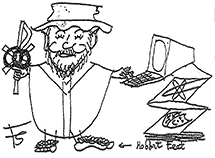During the week around November 15 I found myself on the edge of two raging controversies in Northumberland County, Ontario.The one was an upsurge of controversy focused on Port Hope. An anti-nuclear voice of long standing, that of Dr Helen Caldicott, was raised in protest over the role of uranium processing in this scenic and historic Ontario lakeside town. Her rhetoric shocked even those who had invited her by announcing that the area was hopelessly tainted by radiation, so everyone there should abandon their homes and workplaces and move away! This sudden re-emergence of an old struggle shocked the local people, who saw real estate values and tourist visits in danger. Our Church, St Mark’s, was involved, its parish hall having been reserved for Caldicott’s meeting; the rector and wardens had not bargained for a divisive controversy, instead of which the parish advocates peaceful, reasoned argument. Just as well the venue of the meeting was changed to Oshawa: the three hundred who turned out there could not physically nor legally fit in St Mark’s parish hall.
Latent radiation has been a real worry in Port Hope for over a generation, and those who attribute various forms of illness, from cancer to mental ill-health, cry out in their worry and grief. They rail against vested interest, they undergo paranoia against all levels of government, and with evangelical zeal call for a sort of Last Judgement. The trouble is that Last Judgements are preceded (in mythology) by Armageddon. The people who have extreme views find it easy to disallow the documentation of the long term efforts of government and scientists to deal with actual issues of safety and security in the local uranium processing plant, and who have arranged for the digging up and disposal of potentially tainted soil removal.
The other issue attracting my own attention has been in Campbellford, where the local Legion had a fancy-dress Halloween gala. The first prize for costume was awarded to two men, one dressed in blackface with a noose around his neck, the rope being held by a ‘ghost’ dressed in Ku Klux Klan fearful white. It was a simple representation, or icon, of historical truth. There was widespread horror at this apparent approval of the Klan. To award it first prize immediately signaled the community conscience, (properly) afraid of historical racism: white people murdering black people. It was insensitive, particularly in a community not always noted for tolerance of black people - or some other minorities, such as francophones.
I pause to wonder at the popularity in Canada of the Confederate flag: is it connected in some mysterious way with sports or pop music?
The scene at the Legion was an icon of racial abuse: it was scandalous because it only dramatized one half of the story. If the two men, or the judges, had just thought of what has happened since the American civil war and the American civil rights movement, they would have completed the picture with a simple reversal: put the rope around the neck of the KKK, and the end of the rope in the hands of Blackface. This would have signaled the triumph of racial equality and the condemnation of racism.
In both these controversies, both sides of the debates are tempted by the cry of people caught in unwelcome change, which can leave them and us breathless and uncertain of what to do or where to go:
When in danger or in doubt,
run in circles, scream and shout.
Needed on all sides is calm and peaceful patience, then a realization that we all need to change our ways of thinking and expressing ourselves, to forgive and to receive forgiveness.

